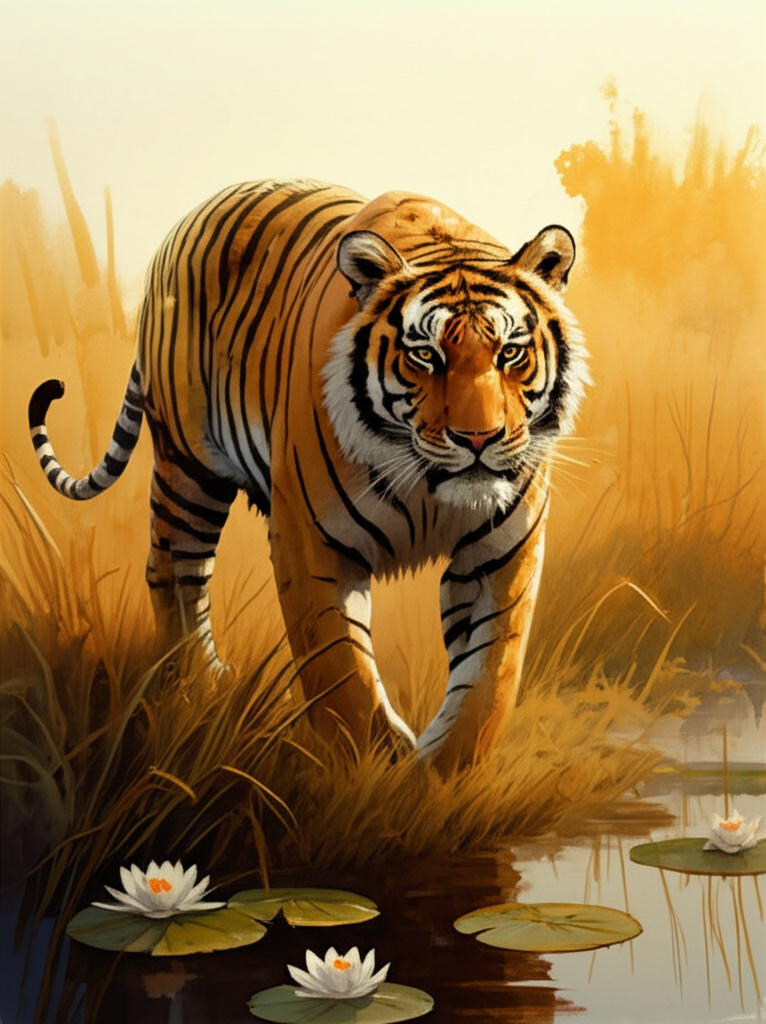
On the left side of the Ganga River, where it comes out of the Himalayan mountains, there’s a long, thick forest. There are villages near the edge of the forest, where farmers and animal herders live. A long time ago, people came to hunt big animals there, so there weren’t as many animals around anymore. The trees were also slowly disappearing. Because the animals lost their food and homes, they moved further up into the mountains.
Once upon a time, about thirty or forty tigers lived in this forest. But people who wanted their skins and heads shot them all. Now, there was only one old tiger left in the jungle. Hunters had tried to catch him too, but he was a smart and clever tiger. He knew how people acted, and he had survived all their traps.
Even though the tiger was old, he was still very impressive. His muscles moved under his yellow and gold fur. He walked through the tall grass like a king who knew he was important, even if he didn’t have as many animal friends as before. His big head went through the leaves, and sometimes you could see his tail waving above the grass.
He was walking to a big swamp to get a drink or cool down. Usually, no one was there except when buffaloes from a nearby village came to swim and play in the mud.
The tiger waited behind a rock, listening for any strange sounds. He knew that hunters sometimes waited there with their guns.
He walked into the water, among the water lilies, and drank slowly. He never rushed when he ate or drank.
He lifted his head and listened, holding one paw up in the air.
A weird sound came to him on the wind, and he was careful of weird sounds. He quickly went into the tall grass by the swamp and climbed a small hill to his favorite rock. The rock was big enough to hide him and give him shade.
The sound he heard was just a flute, sounding quiet in the forest. It was Nandu, a skinny boy with brown skin who rode a buffalo. Nandu was playing the flute really hard. Chottu, a slightly smaller boy, was riding another buffalo behind the herd.
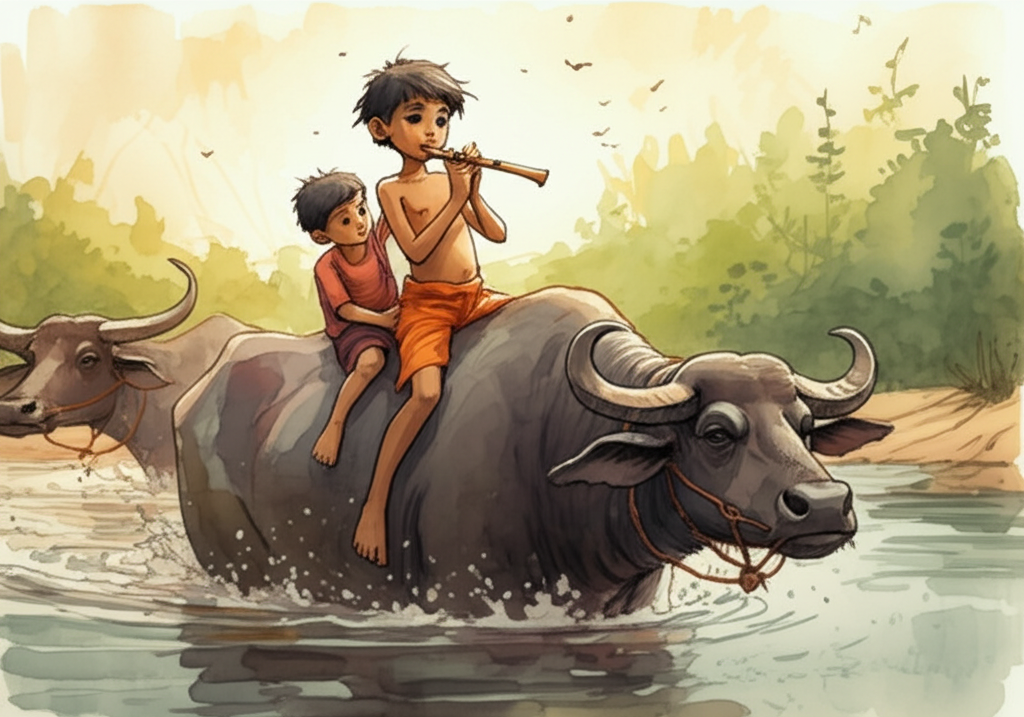
There were eight buffaloes in the herd, and they belonged to Nandu and Chottu’s families. They were cousins. Their dads sold buffalo milk and butter in villages down the river.
The tiger had often seen them at the swamp, and he didn’t mind them. He knew the villagers would leave him alone if he didn’t attack their buffaloes. And as long as there were deer in the jungle, he wouldn’t want to eat anything else.
He decided to go find a cool, shady place in the middle of the jungle to rest during the hot afternoon. He wanted to get away from the flies and mosquitoes that were buzzing around the swamp. He would hunt at night.
He made a lazy grumbling sound that was like a small roar, ‘A-oonh!’ Then he got up and walked slowly into the jungle.
Even the quietest tiger roar can be heard a mile away. The boys, who were very close by, looked up right away.
‘There he goes!’ said Nandu, taking the flute away from his mouth and pointing it towards the hill. ‘Did you see him?’
‘I saw his tail, right before he disappeared. He’s a big tiger!’
‘Don’t call him tiger. Call him Uncle.’
‘Why?’ asked Chottu.
‘Because it’s bad luck to call a tiger a tiger. My dad told me that. But if you meet a tiger and call him Uncle, he will leave you alone.’
‘I get it,’ said Chottu. ‘You have to make him family. I’ll try to remember that.’
The buffaloes were now in the swamp, and some of them were lying down in the mud. Buffaloes love soft, wet mud and will play in it for hours. Nandu and Chottu didn’t like the mud as much, so they went swimming in the deeper water. Later, they rested in the shade of an old silk-cotton tree.
It was evening, and getting dark quickly. The buffalo herd finally went home. Dogs barked, people made noises with their pipes, and there was the cozy smell of smoke outside the village.
The next evening, when Nandu and Chottu came home with the buffalo herd, they saw a group of villagers standing around a jeep. Three strangers with guns were sitting inside. They were hunters, and they had helpers and lots of supplies with them.
They had heard there was a tiger in the area, and they wanted to shoot it.
These men had money to spend. Most of the villagers were poor, so they were willing to go into the forest and build a ‘machaan,’ which is like a platform in a tree, for the hunters. The platform was big enough for the three men and was built in the branches of a tall mahogany tree.
Nandu’s dad told him to tie a goat at the bottom of the tree. While they were getting ready, Chottu went off on his own to look around. He had a plan. He didn’t want the tiger to be killed, so he decided to warn him. He tied pieces of old clothes to small trees and bushes. He knew the clever old king of the jungle would stay away from the area if he saw the clothes, because it meant people were nearby.
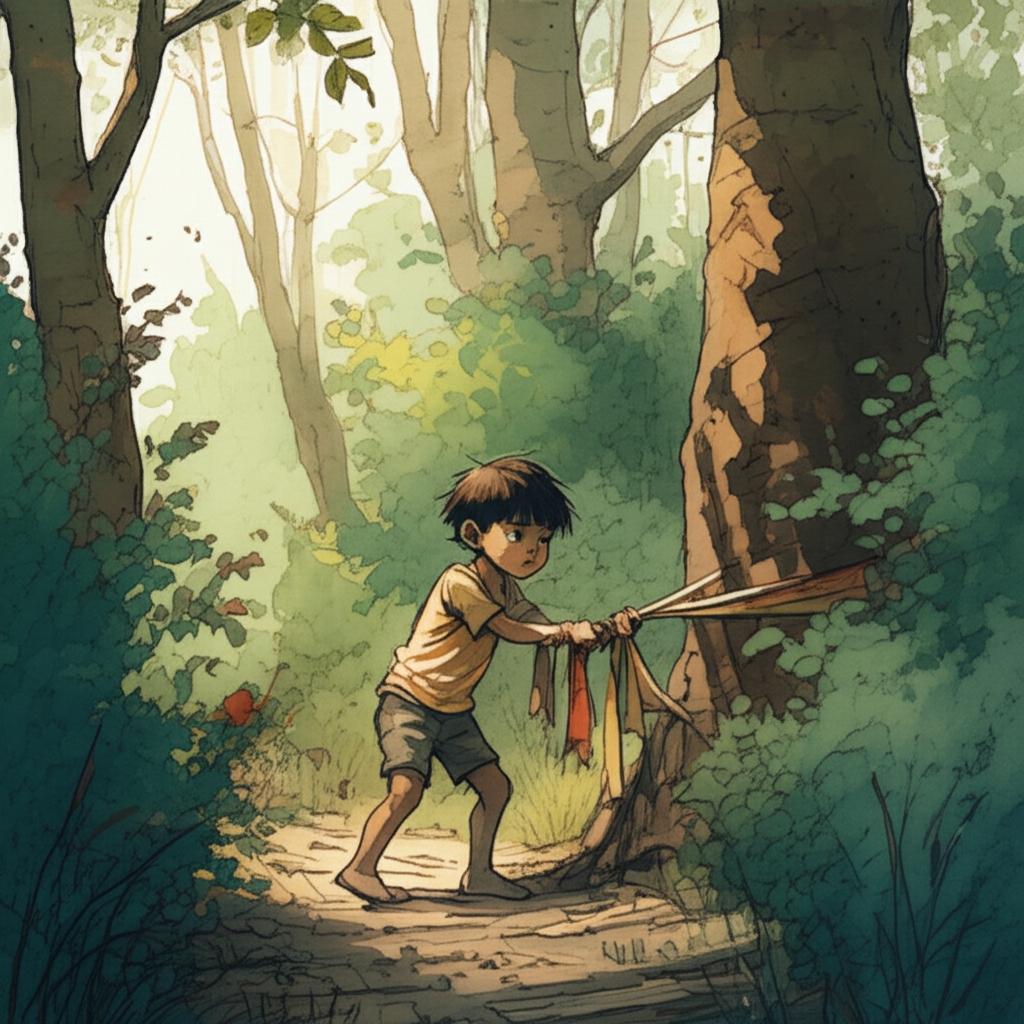
The hunters stayed up all night, but the tiger didn’t come near the tree. Maybe he got Chottu’s warning, or maybe he wasn’t hungry.
It was a cold night, and soon the hunters opened their bottles of rum. They started whispering, then they were talking so loudly that no wild animal would have come close to them. By morning, they were all asleep.
They looked grumpy and embarrassed when they walked back to the village.
‘It’s the wrong time of year for tigers,’ said the first hunter.
‘There’s nothing left in this area,’ said the second.
‘I think I’ve caught a cold,’ said the third. They drove away feeling annoyed.
It wasn’t until the beginning of summer that something happened that changed the tiger’s hunting habits and caused problems with the villagers.
It hadn’t rained for almost two months, and the tall jungle grass was dry and yellow. Some people from the city were camping near the forest and weren’t careful while cooking. They started a forest fire. It slowly spread into the forest, and the smoke pushed the tiger out towards the edge of the jungle. As night came, the fire got brighter and the smell got stronger. The tiger turned and went to the swamp, where he knew he would be safe if he swam to the small island in the middle.
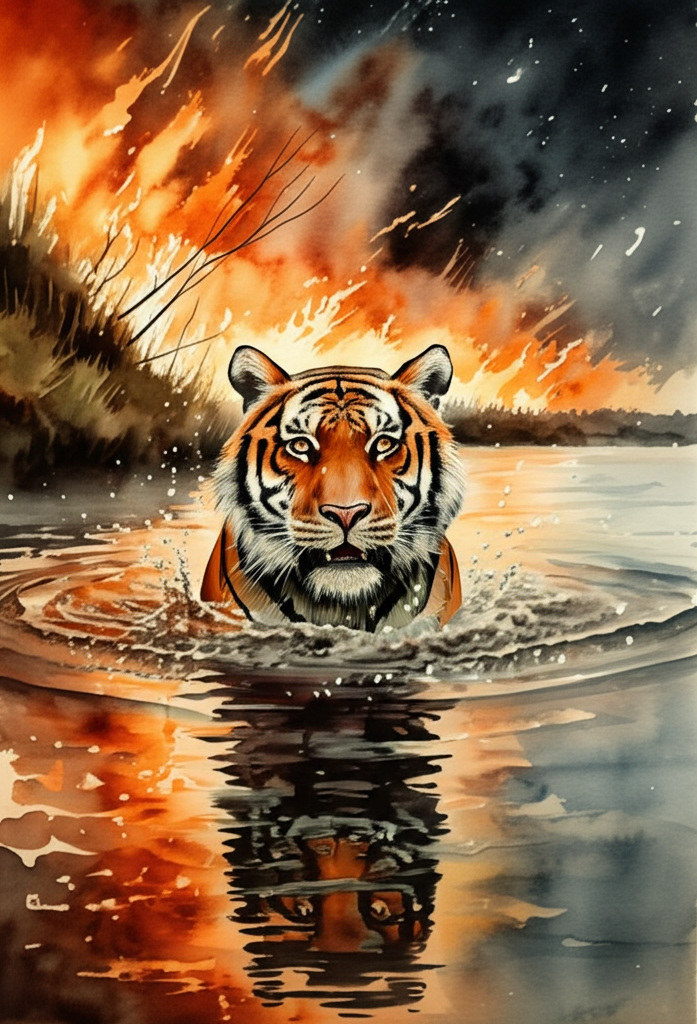
The next morning, he was on the island, which wasn’t touched by the fire. But everything around him had changed. The hills were black with burnt grass, and most of the tall bamboo was gone. The deer and wild pigs couldn’t hide anymore, so they moved further east.
When the fire was gone and the smoke had cleared, the tiger walked through the forest again but couldn’t find any animals. He drank at the swamp and found a shady place to sleep the day away.
The tiger spent four days looking for animals. By then, he was so hungry that he started looking for worms and bugs among the dead leaves and burnt trees. This was sad for the king of the jungle. But he still didn’t want to leave the area to find a new place to hunt, because he was scared of the forests further east. They were quickly being taken over by people. He could have gone north into the high mountains, but there wasn’t any tall grass there for him to hide in.
Early in the morning, he came to the swamp. The water was shallow and muddy, and a green layer was growing on top. He drank, then lay down on his favorite rock, hoping to see a deer, but none came. He was about to get up when he heard an animal coming.
The tiger quickly jumped off the rock and lay flat on the ground, his brown and yellow stripes blending in with the dry grass.
A buffalo came out of the jungle and walked to the water. The buffalo was alone. He was a big male, and his long horns curved back over his shoulders. He walked slowly towards the water, not knowing the tiger was there.
The tiger hesitated before attacking.
It had been a long time since he had killed a buffalo, and he knew the villagers would be angry. But he was so hungry that he couldn’t resist. There was no wind, everything was still, and the buffalo didn’t smell the tiger. A monkey made noises in a nearby tree, but the buffalo didn’t hear him.
The tiger crawled on his stomach, staying close to the edge of the swamp, and came up behind the buffalo. The buffalo was standing in shallow water, drinking, when the tiger jumped out and bit his leg.
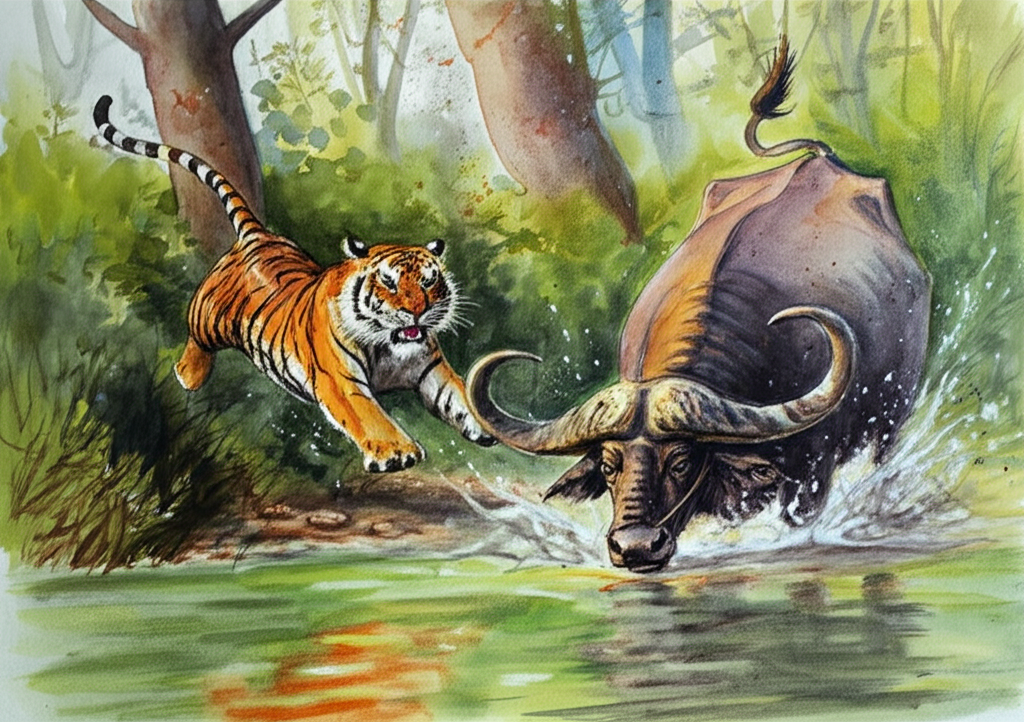
The buffalo stumbled, but turned to fight. He made a noise and lowered his horns at the tiger. But the tiger was too fast for the brave buffalo. He bit the other leg and the buffalo fell to the ground. Then the tiger killed him.
After resting, he started to eat. Even though he had been starving, he couldn’t finish the whole animal. He drank at the swamp and dragged the rest of the buffalo into the bushes to hide it from jackals and vultures. Then he went off to find a place to sleep.
He would come back to eat again when he was hungry.
The herders were very upset when they found out a buffalo was missing. The next day, when Nandu and Chottu ran home to say they had found the half-eaten body near the swamp, the men in the village got angry. They knew that if the tiger realized it was easy to kill their animals, he would do it all the time.
Kundan Singh, Nandu’s dad, who owned the buffalo, said he would go after the tiger himself.
‘It’s too late now,’ said his wife. ‘You should never have let the buffalo go out alone.’
‘He’s been out alone before. This is the first time the tiger has attacked one of our animals.’
‘He must have been hungry,’ said Chottu.
‘Well, we are hungry too,’ said Kundan Singh. ‘Our best buffalo - the only male in the herd! It will cost me lots of money to buy another one.’
‘The tiger will kill again,’ said Chottu’s dad. ‘A long time ago, there was a tiger who did the same thing. He became a cattle-killer.’
‘Should we send for the hunters?’
‘No, they are clumsy fools. The tiger will come back to eat again. Do you have a gun?’
Kundan Singh smiled proudly and brought out a very old gun from a cupboard.
‘My dad bought it from an Englishman,’ he said.
‘How long ago was that?’
‘Around the time I was born.’
‘And have you ever used it?’ asked Chottu’s dad, looking at the old gun carefully.
‘A few years ago, I shot at some bandits. Don’t you remember? When I fired, they ran away and didn’t stop until they had crossed the river.’
‘Yes, but did you hit anyone?’
‘I would have, if someone’s goat hadn’t gotten in the way.’
‘We had roast meat that night,’ said Nandu.
Kundan, along with Chottu’s dad and some other men, went to the swamp. They left the buffalo’s body where it was, because they knew the tiger wouldn’t come near if he thought it was a trap. They built another tree platform in the branches of a tall tree, about thirty feet from the dead buffalo.
Late that evening, Kundan Singh and Chottu’s dad settled down on their rough platform for the night.
Several hours passed, and they only saw a jackal. Then, just as the moon came up over the hills, the two men heard a quiet ‘A-oonh,’ followed by a low, rumbling growl.
Kundan held the old gun tighter. Everything was quiet for a minute or two, then they heard quiet footsteps on the dead leaves under the tree.
A moment later, the tiger walked out into the moonlight and stood over the dead buffalo.
At first, Kundan couldn’t do anything. He was surprised by how big the tiger was. Chottu’s dad had to nudge him. Then Kundan quickly put the gun to his shoulder, aimed at the tiger’s head, and pulled the trigger.
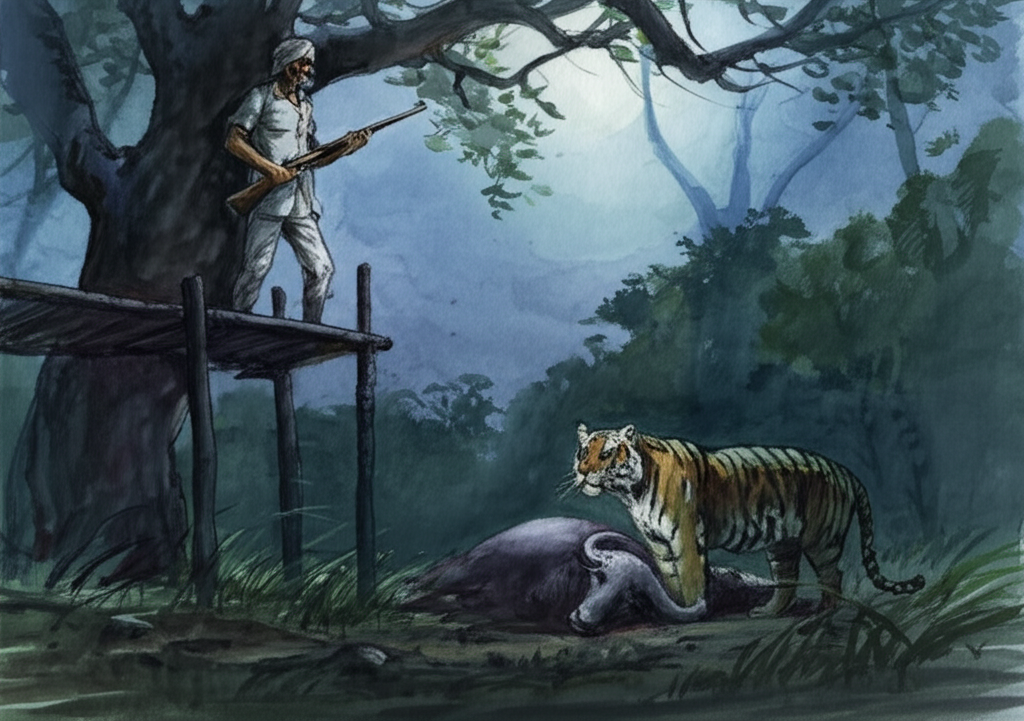
The gun went off with a flash and two loud bangs as Kundan fired both barrels. The tiger roared loudly. He ran at the tree and tried to jump into the branches. Luckily, the platform was high up, and the tiger couldn’t reach it.
He roared again and then ran off into the forest.
‘What a tiger!’ said Kundan, feeling both scared and impressed.
‘You missed him completely,’ said Chottu’s dad.
‘I did not,’ said Kundan. ‘You heard him roar! Would he have been so angry if he hadn’t been hit?’
‘Well, if you only hurt him, he will become a man-eater. What will we do then?’
‘He won’t be back,’ said Kundan. ‘He will leave this area.’
For the next few days, the tiger stayed hidden. He didn’t go near the swamp except when it was very dark and he was very thirsty. The herders and villagers decided the tiger had gone away. Nandu and Chottu, usually with other village boys, and always carrying small axes, started bringing the buffaloes to the swamp again during the day. They were careful not to let any of them wander away from the herd.
But one day, while the boys were taking the herd home, one of the buffaloes fell behind. Nandu didn’t realize an animal was missing until he heard a scared noise behind him. He looked over his shoulder just in time to see the tiger dragging the buffalo into some bamboo. The herd sensed danger, and the buffaloes made scared noises as they hurried along the forest path. To make them go faster and to warn his friends, Nandu made a loud, yodeling sound.
The buffaloes made noises, the boys shouted, and the birds flew away, screaming. Together, they ran out of the forest. The villagers heard the loud sound of hooves and saw the herd coming home in clouds of dust.
‘The tiger!’ shouted Nandu. ‘He’s back! He has taken another buffalo!’
‘He’s not afraid of us anymore,’ thought Chottu. ‘And now everyone will hate him and try to kill him.’
‘Did you see where he went?’ asked Kundan Singh, hurrying up to them.
‘I remember the place,’ said Nandu.
‘Then we have to hurry,’ said Kundan. ‘I will take my gun and some men and wait near the bridge. The rest of you must go through the jungle from this side and push the tiger towards me. He won’t escape this time, unless he swims across the river!’
Kundan took his men and went to the suspension bridge over the river. The others, led by Nandu and Chottu, went to the place where the tiger had grabbed the buffalo.
The tiger was still eating when he heard the men coming. He hadn’t expected to be disturbed so soon. With an angry ‘Whoof!’ he ran into the jungle and watched the men, about twenty of them, through the leaves and tall grass.
The men carried hand drums and some carried sticks and spears. After talking quickly, they spread out in a line and went into the jungle, beating their drums.
The tiger didn’t like the noise. He went deeper into the jungle. But the men followed him, banging their drums and shouting loudly. They walked alone or in pairs, but they were never more than a few steps apart.
The tiger could have easily broken through the line of men. One hit from his paw would have knocked down the strongest of them. But he just wanted to get away from the noise. He hated the noise that humans made.
He wasn’t a man-eater and wouldn’t attack a man unless he was very angry or very scared. Right now, he was neither. He had eaten well and wanted to rest, but he couldn’t rest until the men stopped making so much noise.
Nandu and Chottu stayed close to the older men, because they knew it wouldn’t be safe to go back on their own. Chottu felt sorry for the tiger.
‘Do they have to kill the tiger?’ he asked. ‘If they push him across the river, he won’t come back, will he?’
‘Who knows?’ said Nandu. ‘He has learned that it’s easy to kill our buffaloes, and he’ll come again when he’s hungry. We have to live too.’
Chottu didn’t say anything. He didn’t see any way out for the tiger.
For an hour, the villagers went through the jungle, shouting, drumming, and stepping on the plants.
The tiger couldn’t rest. Whenever he got far enough away from the men to lie down in a shady spot, the noise would come closer, and he would get up with an angry snarl and walk north towards the bridge across the river.
Around noon, the tiger finally came out into the open. The boys could see him clearly as he walked slowly along. Sometimes he was in the sun, which made his fur shine. Other times he was in the shade or in the shorter grass. He was still too far away for Kundan Singh to shoot him, but he couldn’t go back.
He disappeared among some bushes but soon came back. The beaters had done their job well. The tiger was now close to where Kundan Singh was waiting.
The line of men had closed in, and they were all together. They were making lots of noise, but nothing was moving.
Chottu, watching from a distance, wondered, ‘Has he slipped through the beaters?’ He hoped he had.
Tins crashed, drums beat, and some of the men poked into the reeds along the river with their spears or bamboo sticks. Maybe one of them hit the tiger, because he suddenly jumped out of the reeds with an angry snarl. He splashed through the mud and water.
Kundan Singh fired and missed.
The tiger rushed forward, heading straight for the only way across the river - the suspension bridge that led to the hills beyond.
The suspension bridge shook and trembled as the big tiger ran across it.
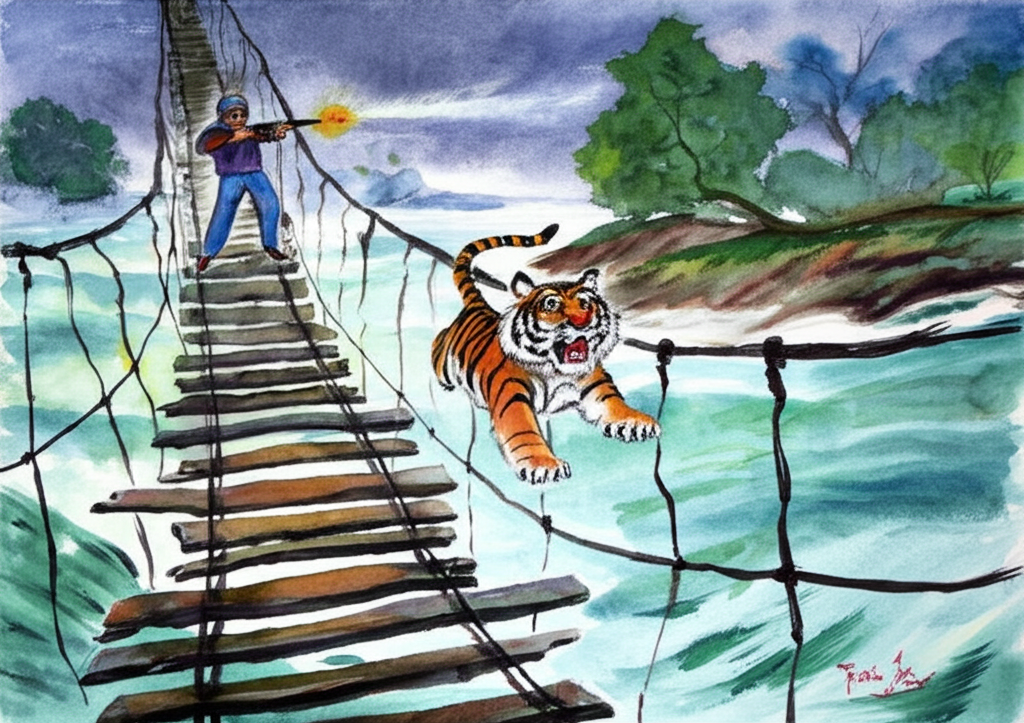
Kundan fired again, and this time the bullet grazed the tiger’s shoulder.
The tiger jumped forward, lost his footing on the slippery planks of the bridge, and fell over the side into the swirling water of the river.
He came up to the surface once, but the current pulled him under and away. Soon, he was gone.
At first, the villagers were happy. They felt their buffaloes were safe. Then they started to feel like something was missing from their lives and from the forest. The forest had been getting smaller every year as more people moved into the area. But as long as the tiger had been there and they had heard him roar at night, they had known there was still some wildness around. Now that the tiger was gone, it was like a protector had left.
The boys lay on their stomachs on their little mud island and watched the rain clouds gathering.
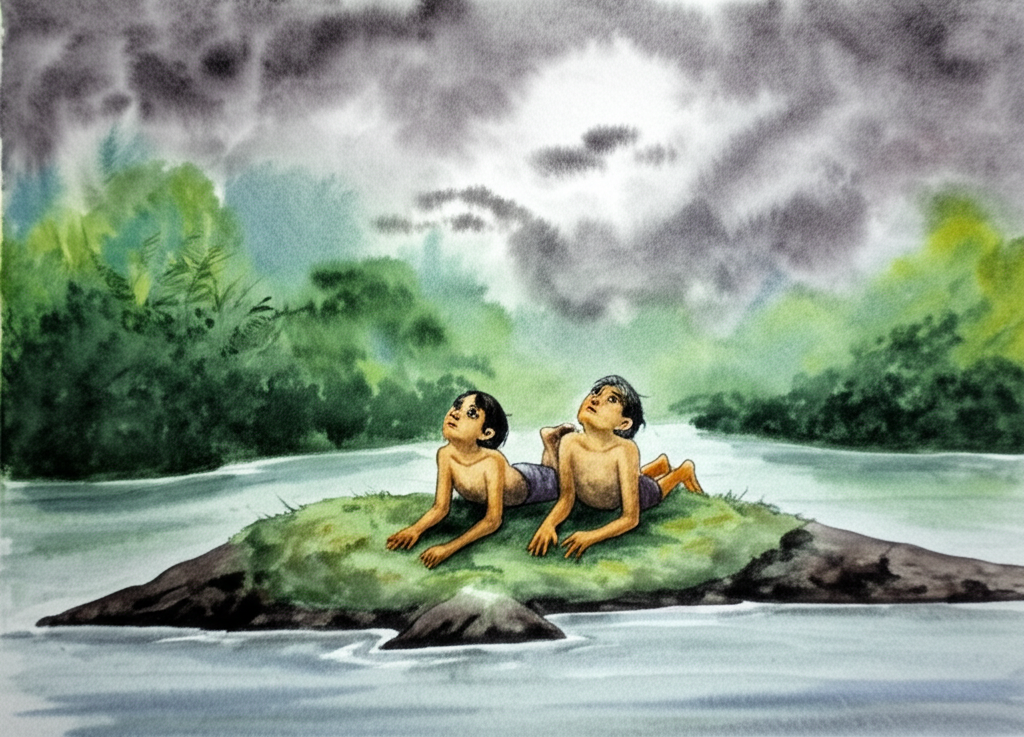
‘The king of the jungle is dead,’ said Nandu. ‘There are no more tigers.’
‘There have to be tigers,’ said Chottu. ‘Can there be an India without tigers?’
The river had carried the tiger far away from his old home, from the forest he had always known. It brought him to the other side of the river, to a strip of warm, yellow sand. Here, he lay in the sun, breathing slowly.
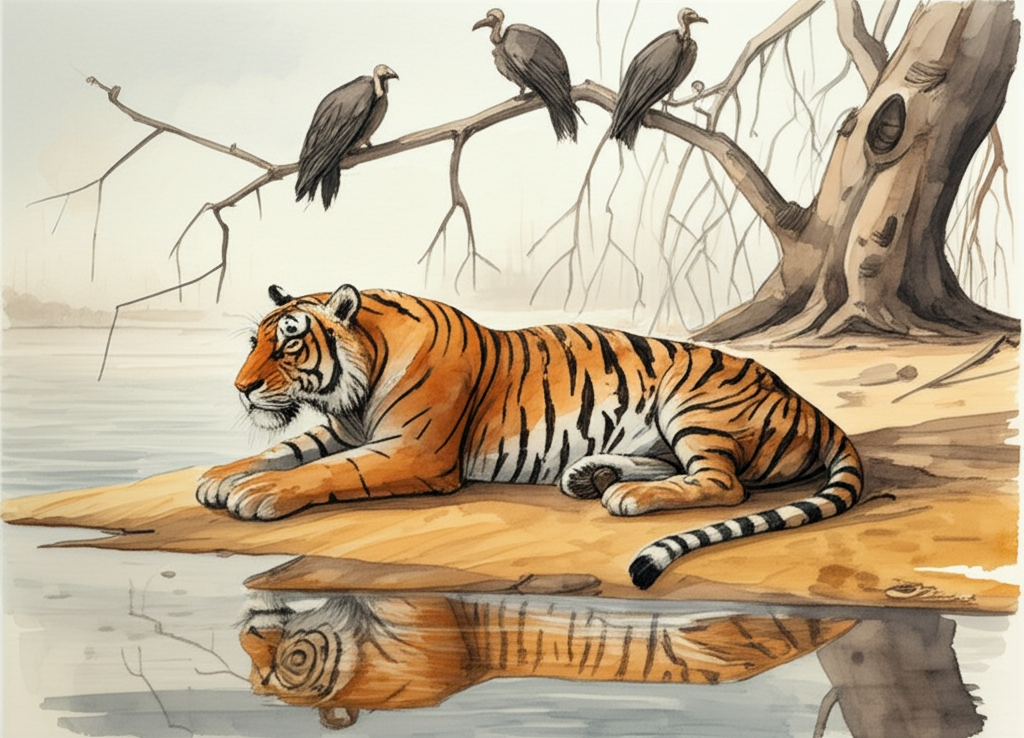
Vultures gathered and waited at a distance, some of them sitting on the branches of nearby trees. But the tiger was more drowned than hurt. As the river water came out of his mouth and the warm sun brought new life back into his body, he moved and stretched, and his eyes focused. He lifted his head and saw trees and tall grass.
Slowly, he pulled himself off the ground and walked to where the tall grass waved in the wind. Would he be hunted again and shot at? There was no smell of man. The tiger walked forward more confidently.
But there was another smell in the air, a smell that reminded him of when he was young and strong. A smell he had almost forgotten but could never really forget - the smell of a tigress!
He lifted his head, and new life surged through his body. He gave a deep roar, ‘A-oonh!’ and walked purposefully through the tall grass. The roar came back to him, calling him, urging him forward. It was a roar that meant there would be more tigers in the land!
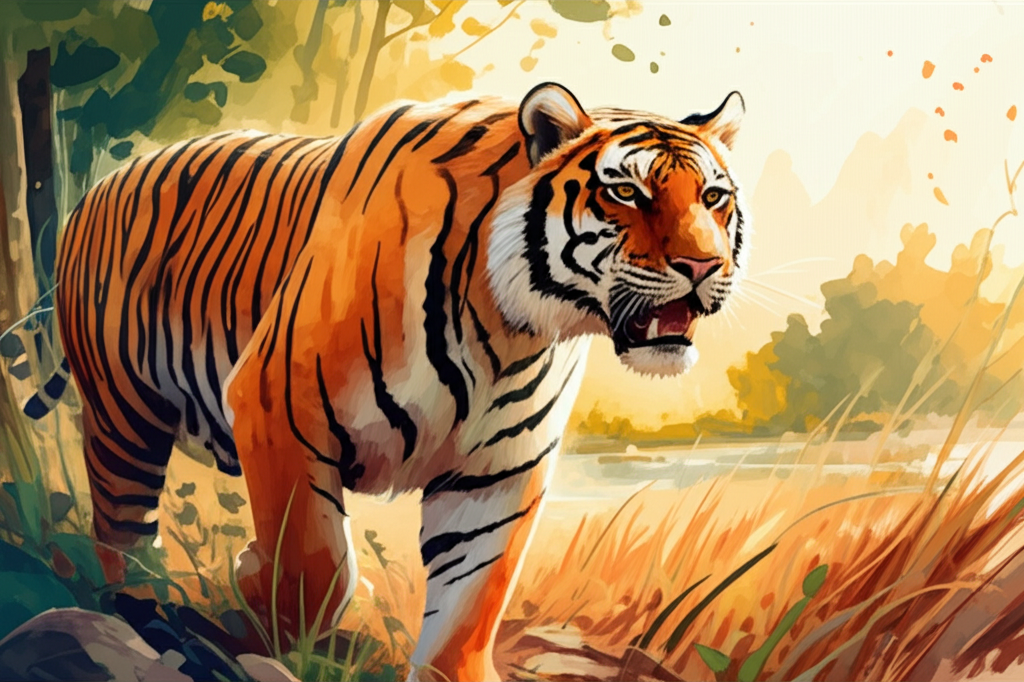
That night, half asleep in his bed, Chottu heard the tigers roaring to each other across the river. He recognized the roar of his own tiger. He knew it was alive and safe, and he was happy.
‘Let there be tigers forever,’ he whispered into the darkness before he fell asleep.